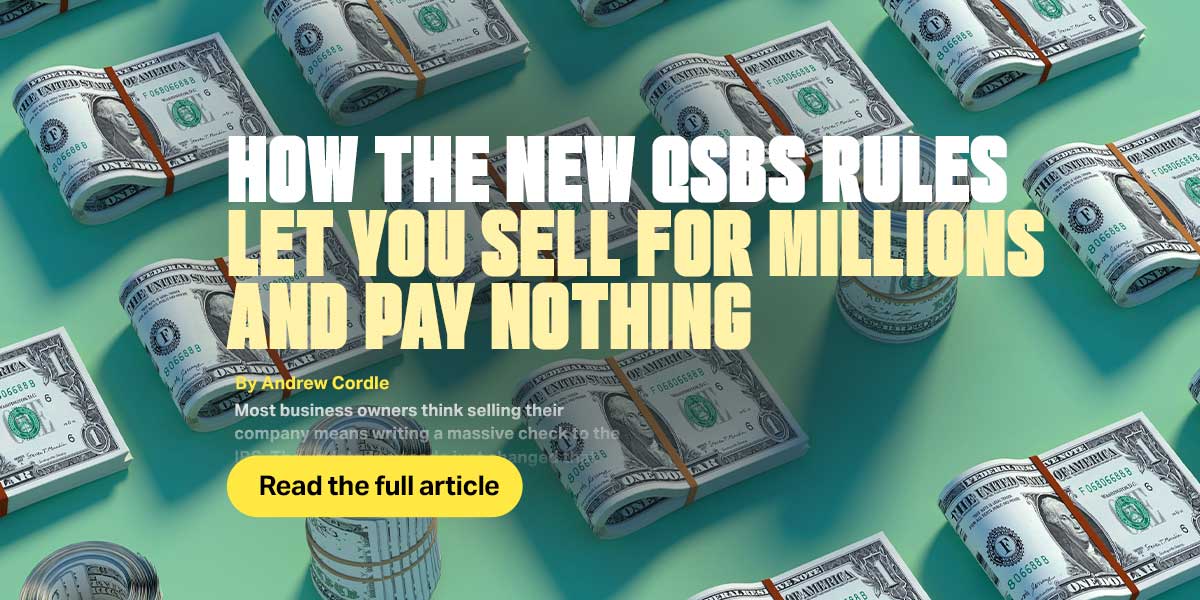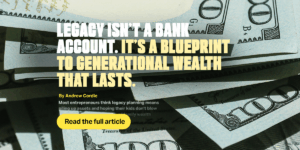Most business owners think selling their company means writing a massive check to the IRS. The updated tax code just changed that game forever.
If you’ve built a business worth $10 million and you sell it, you’d normally owe around $2.4 million in federal capital gains taxes. But what if I told you there’s a legal way to owe exactly zero? Not through sketchy offshore accounts or creative accounting—through a provision in the tax code that just got significantly more powerful.
Welcome to the expanded world of Qualified Small Business Stock (QSBS).
The Secret Exit Strategy Hidden in Plain Sight
QSBS has existed since 1993, but it lived in obscurity because the rules were restrictive and the benefits felt limited. The Big Beautiful Tax Bill just turned this from a niche strategy into the ultimate founder’s exit plan.
Here’s what changed: The new provisions expanded which businesses qualify, extended the tax-free holding period to 20 years, and—this is the big one—allowed you to stack the exemption using multiple trusts to multiply your tax-free gains.
Translation: If you structure this correctly, you can sell your business for tens of millions and legally pay zero federal capital gains tax.
What Actually Qualifies Now
The expanded QSBS rules cover far more businesses than before. Your company qualifies if:
- It’s a C-corporation (not an LLC or S-corp)
- You held the stock for at least five years
- The business has gross assets under $50 million when you acquired the stock
- At least 80% of assets are used in an active business (not passive investments)
The updated provisions expanded “active business” to include many service companies, technology firms, and consulting businesses that were previously excluded. If you’re running a digital marketing agency, software company, or professional services firm, you likely qualify now.
The 20-Year Tax-Free Window
Here’s where it gets interesting. Under the new rules, if you hold qualifying stock for 20 years instead of the original five-year minimum, you can exclude up to $50 million in gains from federal taxes per person.
But the real strategy isn’t waiting 20 years—it’s using the expanded stacking provisions.
The Trust Multiplication Strategy
The updated QSBS rules allow you to establish multiple qualified small business investment trusts (QSBITs), each with its own $50 million exemption. Here’s how wealthy founders are using this:
Let’s say you own 100% of a company you expect to sell for $20 million in seven years. Instead of holding all the stock personally, you transfer portions to multiple trusts—each qualifying for its own QSBS exemption.
Trust 1: Holds 25% of company stock
Trust 2: Holds 25% of company stock
Trust 3: Holds 25% of company stock
Personal Holdings: 25% of company stock
When you sell, each entity gets its own exemption. What would have been a $20 million taxable gain requiring $4.8 million in federal taxes becomes completely tax-free across the four structures.
The Real-World Math
Consider two founders selling identical $15 million companies:
Founder A (traditional exit):
- Sale proceeds: $15 million
- Federal capital gains tax (24%): $3.6 million
- Net proceeds: $11.4 million
Founder B (QSBS strategy):
- Sale proceeds: $15 million
- Federal capital gains tax: $0
- Net proceeds: $15 million
The difference? Founder B structured their ownership through qualifying QSBS entities and held for the required period. Same business, same sale price, $3.6 million more in their pocket.
Why Your CPA Isn’t Mentioning This
Most accountants focus on annual tax planning, not multi-year exit strategies. QSBS requires forward-thinking structure work—converting to C-corp status, establishing trusts, and planning years in advance.
Many CPAs simply don’t operate at this level. They’re optimizing your quarterly payments, not architecting your exit strategy. This is advanced wealth planning that requires specialized knowledge of business structures, trust law, and long-term tax strategy.
The C-Corp Conversion Decision
The biggest barrier for most entrepreneurs is the C-corp requirement. If you’re currently an LLC or S-corp, you’ll need to convert, which can trigger immediate tax consequences.
But here’s the calculation: Pay some taxes now on the conversion, or pay massive taxes later on the entire sale. For businesses expecting significant growth, the conversion often pays for itself many times over.
The key is timing. Convert early in your business growth when valuations are lower, minimizing conversion taxes while maximizing future QSBS benefits.
Beyond Federal Taxes
While QSBS eliminates federal capital gains taxes, state treatment varies. Some states honor the federal exemption, others don’t. But even in high-tax states, eliminating federal obligations saves founders millions.
Additionally, the expanded rules include provisions for rolling QSBS gains into new qualifying investments, allowing serial entrepreneurs to continuously defer taxes while building new ventures.
The Generational Wealth Accelerator
The most sophisticated founders use QSBS as part of broader wealth transfer strategies. By establishing QSBS trusts for children and grandchildren, they can pass business ownership to future generations while preserving the tax benefits.
This isn’t just about your exit—it’s about creating a structure that benefits your family for decades.
The Planning Window Is Now
QSBS benefits require years of advance planning. You can’t decide to use this strategy six months before your exit. The holding periods, corporate structure requirements, and trust establishments need time to mature.
If you’re building a business you plan to sell, the conversation about QSBS should happen today, not when investment bankers start calling.
The Game Behind the Game
The expanded QSBS provisions represent something bigger than tax savings—they’re evidence of how the tax code is designed to reward business builders and job creators, not just income earners.
While W-2 employees debate marginal tax rates, founders who understand these structures are architecting exits that bypass those conversations entirely.
The updated rules didn’t create a loophole. They expanded a legal pathway that rewards entrepreneurial risk with tax benefits that can preserve millions in wealth.
Most founders will sell their companies and write massive checks to the IRS because they didn’t know this pathway existed. The question isn’t whether QSBS works—it’s whether you’ll learn the rules in time to use them.
The tax code rewards those who understand it. Everything else is just expensive ignorance.






